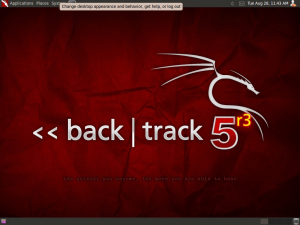Hello to All The Mindbenders,
Okay, so the first thing you’re wondering is
“Why the hell would you want to do this?”
Well the answer becomes more obvious when the scenario is set:
You’re on a social engineering job and you’ve managed to gain access to the target building, you walk around for a bit to see if any of the desks look free. After a while you decide to sit down at what seems like an unoccupied desk. You calmly pull out your laptop and turn it on. As the laptop is booting you start looking for an Ethernet cable to plug into your laptop, you find one and plug it in. Social engineering phase complete, pentest about to start. The hard work is over and the fun is about to begin…. until, someone walks past your laptop and sees you’re bright red coloured BackTrack wall paper.
You’re on a social engineering job and you’ve managed to gain access to the target building, you walk around for a bit to see if any of the desks look free. After a while you decide to sit down at what seems like an unoccupied desk. You calmly pull out your laptop and turn it on. As the laptop is booting you start looking for an Ethernet cable to plug into your laptop, you find one and plug it in. Social engineering phase complete, pentest about to start. The hard work is over and the fun is about to begin…. until, someone walks past your laptop and sees you’re bright red coloured BackTrack wall paper.
this one is nice trick just keep it low. you know what i mean.
you dont want to have that Big red dragon logon on your screen. let them tought it was a noob OS lol :P
you dont want to have that Big red dragon logon on your screen. let them tought it was a noob OS lol :P

You’re no longer being stealthy, the wallpaper looks aggressive and the nature of your visit is becoming a concern to the other workers who realise they’ve never seen you before. Next thing you know you’ve been collared by security and before you know it you’ve kicked out of the building, all because of the wallpaper on your laptop!
This script originally came from here but I have neatened it up and got it working with BackTrack. So the idea of this script is to make it quick to turn your BackTrack5 gnome build into something that resembles Windows XP to help you blend in with the crowd.
The package can be downloaded from here (please don’t hotlink as I might move the file to a different server to cope with all the downloads….):
















